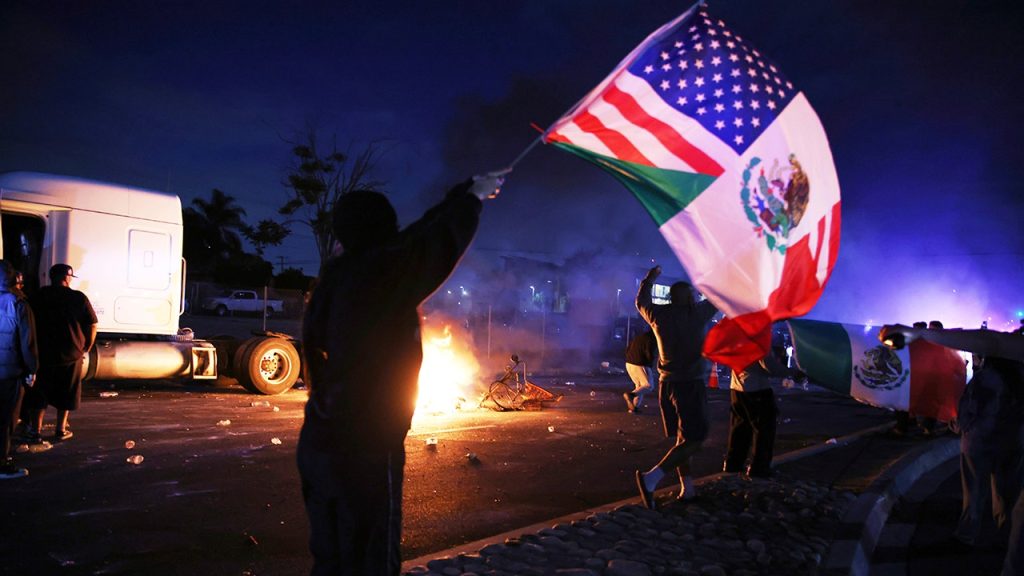Tensions escalated in Los Angeles over the weekend as widespread protests against Immigration and Customs Enforcement (ICE) culminated in violence and mass arrests. Following a series of immigration raids, demonstrators clashed with law enforcement, resulting in nearly forty arrests across various agencies. As authorities grapple with this unrest, the sentiment among protestors highlights growing frustrations surrounding immigration policies and community safety.
| Article Subheadings |
|---|
| 1) Protests Erupt Following ICE Raids |
| 2) Arrests and Charges Amidst Chaos |
| 3) Government Response to Unrest |
| 4) Community Voices on Immigration Policies |
| 5) Looking Ahead: Potential for Continued Unrest |
Protests Erupt Following ICE Raids
The protests began on Friday, ignited by a series of immigration raids conducted by ICE in Los Angeles’ garment district. As federal agents sought to detain undocumented immigrants, the local community’s frustrations erupted into protests, marking the beginning of a tumultuous weekend. Protesters gathered in significant numbers, expressing their dissent against federal immigration enforcement and calling for the protection of vulnerable populations within their neighborhoods.
Organizers of the demonstrations aimed to draw attention to harsh immigration policies that they believe disproportionately affect Latino communities in Los Angeles. The city, known for its diverse population and status as a sanctuary city, has seen tensions rise consistently during previous ICE operations, but this particular weekend marked a severe escalation in both protests and responses from law enforcement.
Arrests and Charges Amidst Chaos
Over the course of the weekend, law enforcement agencies arrested 41 protesters, including 21 by the Los Angeles Police Department (LAPD) and 19 by the California Highway Patrol. The charges ranged from failure to disperse to more severe accusations, such as attempted murder involving a Molotov cocktail. As chaos unfolded, protesters engaged in acts of vandalism, including broken windows at police headquarters and setting self-driving cars ablaze.
The LAPD reported that initial arrests on Saturday were followed by a significant uptick in violence on Sunday. By that afternoon, additional crowd-control measures were employed, including the use of smoke-filled canisters to disperse crowds. These actions were met with further agitation from demonstrators, leading to confrontations across major intersections and highways, culminating in blocked roads and stand-offs with police.
Government Response to Unrest
In response to the unrest, President Donald Trump deployed 2,000 National Guard troops to Los Angeles, asserting the need for military presence to prevent further violence. This tactical decision quickly drew mixed reactions from local and state officials, particularly among Democrats. California Governor Gavin Newsom criticized the deployment as authoritarian, stating, “This is about power, ego, and command control.”
Furthermore, national officials highlighted the dangers of inflaming tensions through aggressive rhetoric surrounding immigration. Federal officials expressed concerns that inflammatory statements from political leaders could exacerbate the already fraught environment among protesters and law enforcement.
Community Voices on Immigration Policies
Members of the Los Angeles community have taken to the streets not only to protest ICE’s actions but also to voice broader concerns about immigration policy and its impact on their lives. Many community leaders argue that the recent raids contribute to a culture of fear and mistrust between immigrant populations and law enforcement. The anger evident in the protests reflects a desire for reforms in how immigration laws are enforced in conjunction with community safety.
Protesters have articulated their grievances by sharing personal stories that underscore the human costs of immigration enforcement. Many express that policies enacted from the federal level disconnect communities from the local support systems they require. “We are not criminals; we are families,” stated one demonstrator, highlighting the challenges faced by those caught in the crossfire of immigration enforcement and societal stigma.
Looking Ahead: Potential for Continued Unrest
As Los Angeles braces for possible further unrest, discussions are ongoing within the community about how to address the underlying issues driving these protests. Local leaders are attempting to foster dialogue between law enforcement and residents, seeking to build trust and mitigate polarizing effects stemming from federal immigration policies.
Anticipation of additional protests remains high, with many community members pledging to continue their activism until significant changes are made. The outcome of this current surge in protests may serve as a pivotal moment in the broader dialogue surrounding immigration policies, community safety, and local governance.
| No. | Key Points |
|---|---|
| 1 | Protests in Los Angeles ignited by ICE raids led to significant civil unrest and over 40 arrests. |
| 2 | Charges against protesters include serious offenses, reflecting the intensity of the confrontations. |
| 3 | Government responses include the deployment of National Guard troops and criticism from local leaders. |
| 4 | Community members voice grievances over immigration policies, pushing for reform and dialogue. |
| 5 | Ongoing protests are anticipated as leaders seek to address underlying issues in immigration enforcement. |
Summary
The recent protests in Los Angeles over ICE raids reflect deep-seated issues regarding immigration policies and their enforcement within communities. As tensions rise and violence erupts, both local leaders and federal officials will need to engage constructively with constituents to address the root causes of unrest. The potential for continued demonstrations lies not only in the immediate responses to enforcement actions but also in the broader societal context surrounding immigration and community safety.
Frequently Asked Questions
Question: What initiated the protests in Los Angeles?
The protests were initiated following a series of immigration raids conducted by ICE in the city’s garment district, igniting community anger over enforcement actions against undocumented immigrants.
Question: What are the implications of the government response to the protests?
The government’s deployment of National Guard troops has raised concerns about authoritarian measures and the militarization of local law enforcement, prompting critical responses from state officials.
Question: What are the broader community impacts of the protests?
These protests highlight widespread concerns about immigration policies and their effects on community cohesion and safety, emphasizing a need for dialogue and reform in how such policies are enforced.


